Carbohydrates are polyhydroxy (containing multiple hydroxyl groups) aldehyde and ketones
Carbohydrates are a very diverse class of sugars since they have multiple reactive/modifiable sites i.e., the hydroxyl groups. They acquire large amount of structures, some carbohydrates structure examples are listed in this article
Monosaccharides Are Aldehydes or Ketones with Multiple Hydroxyl Groups
An aldose is an aldehyde group containing carbohydrate (similar to the glucose and glyceraldehyde), though a keto group containing carbohydrate is known as ketose (similar to the fructose and dihydroxyacetone). A sugar is known as the D-sugar if the asymmetric carbon farthest from the carbonyl carbon (carbon atom of aldehyde or keto group) contains H on its left side, if OH group is on the left side then the sugar is known as L-sugar.
Monosaccharides are the simplest carbohydrates that contains ketones or aldehydes that have two or more hydroxyl groups. Monosaccharides have an empirical formula (C-H2O)n
The simplest and smallest monosaccharides, for which n = 3, are d and l-glyceraldehyde and dihydroxyacetone
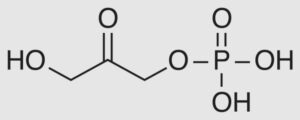
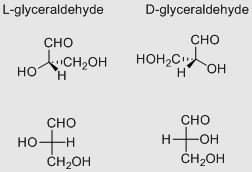
Most of the sugars present naturally are the D-sugars. The carbon atom of the aldehyde group (C-1 or anomeric carbon) reacts with the hydroxyl group of the fifth carbon atom (C-5) to frame a six-membered pyranose ring.
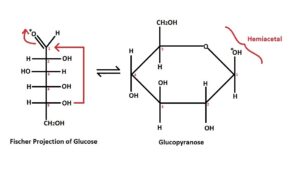
The carbon atom of the keto group (C-2) in the open-chain conformation of fructose reacts with the hydroxyl group of the fifth carbon (C-5) to shape a five-membered furanose ring. Pentoses, for example, ribose and deoxyribose contains furanose rings as their framework.
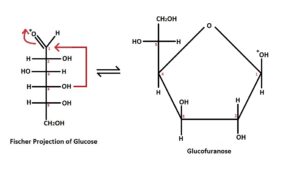
An extra point of asymmetry is formed at the anomeric carbon (C-1 in case of aldose sugars and C-2 in case of ketoses sugars) during the formation of cyclic products. The OH group connected to the anomeric carbon is beneath the plane of the ring in the alpha-anomeric form, however OH group is over the ring in the beta-anomeric form. Few atoms of the ring are not found in the same plane.
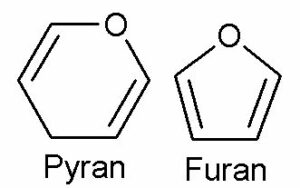
They make up most of the natural mass on Earth as they have major roles in the structural organization as well as physiology of living organisms. To start with, sugars fill in as metabolic intermediates, fuels as well as energy stores. Furthermore, ribose and deoxyribose sugars forms the primary framework of DNA and RNA.
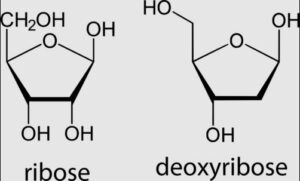
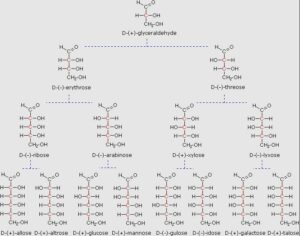
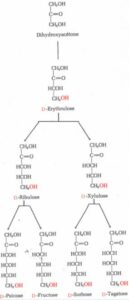
The prevalent types of fructose, glucose, ribose, and numerous different sugars in dissolved form are not open chains.


Complex Carbohydrates Are Formed by Linkage of Monosaccharides
Sugars units connect each other via O-glycosidic bonds to produce disaccharides and polysaccharides. Maltose, lactose and sucrose are the most commonly occurring disaccharides. Sucrose (commonly consumed as table sugar) comprises of beta -fructose and alpha – glucose linked together by a glycosidic linkage between their anomeric carbon atoms. Lactose (in milk) comprises of glucose and galactose are linked together by beta-1,4 linkage.
Maltose (obtained from starch digestion) comprises of two glucose units joined together by alpha-1,4 glycosidic linkage.
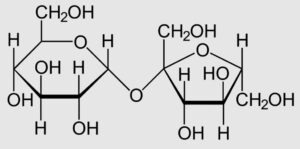
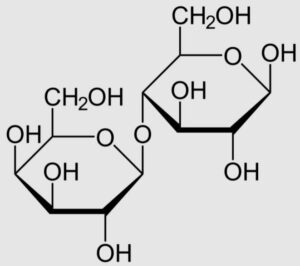

Monosaccharides Are Joined to Alcohols and Amines Through Glycosidic Bonds
Monosaccharides undergo chemical modification by reacting with amines and alcohols to produce adducts.
The new bond is formed between the oxygen atom of the hydroxyl group of methanol and anomeric carbon of glucose, this bond is known as the o-glycosidic bond. In the formation of N-glycosidic bond nitrogen atom of amine group of protein connects with the anomeric carbon of a sugar.


Complex Carbohydrates Are Formed by Linkage of Monosaccharides
Since sugars molecules have numerous hydroxyl groups, glycosidic bonds can also take place between monosaccharide units. Oligosaccharides are formed by the association of at least two monosaccharides linked through O-glycosidic bonds
Examples of oligosaccharides (di and trisaccharides)n
maltose, for instance, has two D-glucose units that are linked together by a glycosidic linkage between the hydroxyl oxygen on C-4 of one sugar and a -anomeric carbon of C-1 of the adjacent sugar unit. Such a linkage is called a alpha-1,4-glycosidic bond.
Polysaccharides are the framework components in plants and bacterial cell wall. Indeed, cellulose (a bio-polymer present in plant cell wall) is the primary constituent of plant cell wall. Thus, cellulose is one of the most abundant substance in the ecosystem.
Starch is a bio-polymer made of glucose, it is predominant in plants, and in animals glycogen is present as the polymer of glucose instead of glycogen. The greater portion of the glucose units in glycogen and starch contains alpha -1,4 linkage. Branching points contains alpha -1,6 linkages, glycogen has more branching points as compared to starch which makes glycogen more soluble in water.
Cellulose, the major framework forming polymer of plant cell walls. It comprises of glucose subunits joined together by beta -1,4 linkages. These beta-linkages bring about long straight chains that constitute fibrils with high rigidity. Conversely, the a linkages in glycogen and starch form open helices, with regards to their jobs as they mobilizable energy stores.
Animal cells has extra cellular matrices and cell surfaces containing polymers of recurring disaccharides known as glycosaminoglycans. One of the units in each repetitive unit is a of galactosamine or a glucosamine derivative. These carbohydrates are profoundly anionic and have numerous sulfate and carboxylate groups. Proteins having covalently connected glycosaminoglycans are named as proteoglycans.
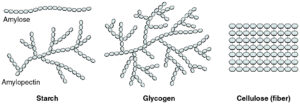
Carbohydrates Can Be Attached to Proteins to Form Glycoproteins
Carbohydrates are also found connected to numerous proteins and lipids, where they perform important functions in the cellular interactions.
Explicit enzymes transfers the oligosaccharide units on proteins either to the side-chain nitrogen atom of the amide group present in the asparagine or to the oxygen atom present in the seide chain of threonine and serine. This process is known as glycosylation of proteins, glycosylation occurs in endoplasmic reticulum.
The N-connected oligosaccharides are formed on dolichol phosphate and then transferred to the acceptor protein. Extra sugars are linked in the Golgi complex.
carbohydrates are covalently joined to a wide range of proteins to synthesize glycoproteins. Carbohydrates are present in a lesser amount as compared to the weight of glycoproteins than proteoglycans.
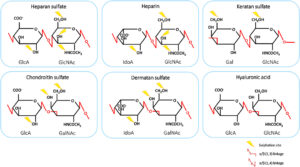
Also Read:
- Polymerase chain reaction
- How are nucleotides produced
- Do animal cells have cytoplasm
- Do prokaryotes have centrioles
- Pathogenic fungi examples
- Bees examples
- Sea anemone characteristics
- Cell membrane structure in plant cell
- Enzymes and substrates
- Protein denaturation temperature

I am Abdullah Arsalan , Completed my PhD in Biotechnology. I have 7 years of research experience. I have published 6 papers so far in the journals of international repute with an average impact factor of 4.5 and few more are in consideration. I have presented research papers in various national and international conferences. My subject area of interest is biotechnology and biochemistry with special emphasis on Protein chemistry, enzymology, immunology, biophysical techniques and molecular biology.